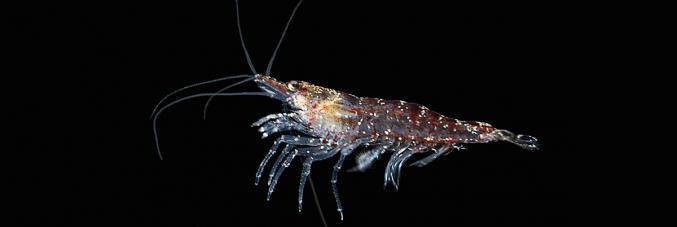
The Enormous Krill Genome
29.03.2023
Antarctic krill (Euphausia superba) is the most abundant animal species on the planet, holding a biomass of between 300 and 500 million tonnes. Playing a vital role in the Antarctic ecosystem, this small crustacean forms an ecological link between primary producers that make up the phytoplankton and higher levels of the food chain such as seabirds, seals, penguins, and whales.
Due to its enormous biomass, krill significantly affects fundamental global biogeochemical processes such as carbon cycles and iron recycling. Studying their biological ability to adapt to an ever-changing environment, especially that of global warming is fundamental. Until now, the impossibility of reconstructing the sequence of the krill genome – 15 times larger than the human one – has represented an insurmountable technical obstacle for the study of the physiological, molecular and genetic aspects of krill.
Published in Cell, the research paper tackling this question is entitled The enormous repetitive Antarctic krill genome reveals environmental adaptations and population insights. Submitted by Changwei Shao of the Yellow Sea Fisheries Research Institute of Qingdao, the research work is a collaboration that includes Cristiano De Pittà and Gabriele Sales of the University of Padua’s Department of Biology and Alberto Biscontin (now at the University of Udine). Researchers used the most innovative sequencing technologies and up-to-date analysis methods to generate the entire krill genome assembly, their work turned out to be the largest animal assembly reported to date.
Its enormous size appears to be the result of the duplication and movement of numerous segments of DNA referred to as inter-genic transposable element expansion. As locations in the genome, and not duplications of the entire genome, are found in other species. In particular, two recent events of accumulation of transposable elements, both linked to climate change, are considered responsible for the current large size of the genome.
Dr Biscontin explains, "Genome sequencing has made it possible to identify 625 genes whose expression appears to be under the direct control of the circadian clock and could therefore represent the fulcrum of the physiological and behavioural adaptation process as this organism is subjected to extreme seasonal variations."
Furthermore, the presence of the Antarctic Circumpolar Current (ACC) is responsible for very high levels of connectivity between the different geographical areas. For years, scientists considered the Antarctic krill population to be genetically homogeneous. Sequencing its genome has led to the identification of millions of new genetic markers (Single Nucleotide Polymorphisms ) which allows researchers to perform a complete analysis of the structure of the Antarctic krill population for the first time while highlighting the genetic traces of four different ancestral populations from many geographical regions.



